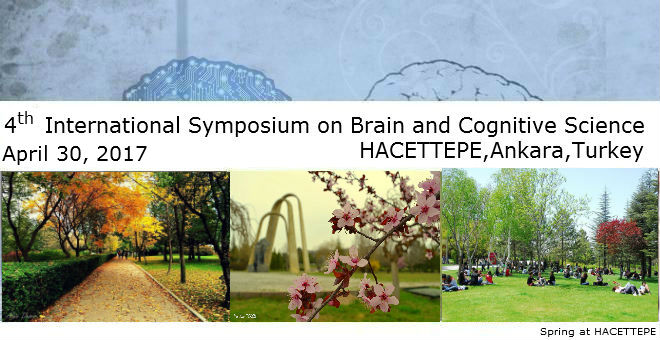4th International Symposium on Brain and Cognitive Science April 30,2017 Hacettepe, Ankara, Turkey
Cognitive science is the interdisciplinary research field that seeks to understand the nature of the human mind and other minds, including artificial minds, with all its implications. The International Symposium on Brain and Cognitive Science (ISBCS) invites research from all the fields that are connected to cognitive science. The individual disciplines include Artificial Intelligence, Linguistics, Computer Science, Anthropology, Psychology, Neuroscience, Philosophy, and Education. Each discipline brings a set of tools, perspectives, and questions to the table. However, the big picture of the mind cannot emerge by studying this multi-layered problem with a single lens. Communication and collaboration are essential for the cognitive scientist. It is under these premises that we initiate ISBCS.
One mission of ISBCS is to be a premier academic meeting of the cognitive science community. Established jointly by Middle East Technical University (ODTÜ), Bogazici University and Yeditepe University (i.e. by the three universities that offer cognitive science programs in Turkey), ISBCS is going to be held annually to gather researchers and students from leading national and international centers working on all areas of cognitive science. Our aim is to establish a platform where students can learn about recent research in cognitive science, researchers can get together and initiate collaborations, and the participants can receive valuable feedback on their work. .
Program (Tentative)
Abstracts of the Talks
Shimon Ullman- Atoms of Recognition and Top-down processing
The human visual system makes highly effective use of limited information: it can recognize not only objects, but also severely reduced sub-configurations in terms of size or resolution. The ability to recognize such minimal images is crucial for the interpretation of complex scenes, but is also challenging because recognition in this case depends on the effective use of all the available information. Our human and computer vision studies show that humans and existing models are very different in their ability to interpret minimal images. In particular, human vision combines bottom-up and top-down processing to achieve full interpretation of the object image. I will describe our studies and discuss implications to the representations used for recognition, brain mechanisms involved, and algorithms for the interpretation of complex scenes.
Deniz Yüret- Learning to follow navigational instructions
In this talk we will explore the problem of teaching a computer to follow natural language instructions using examples of instruction-action pairs collected from humans in a maze like environment. This problem is an example of grounded language learning, where the learning agent starts with no linguistic knowledge and has to infer the meanings of words, phrases, and sentences from example interactions. Recently, deep learning models for sequence-to-sequence mapping, originally developed for machine translation, were adapted for the grounded language learning problem. Instead of translating a source language to a target language, grounded language learning can be seen as translating the instruction sequence to an action sequence mediated by perceptual information from the world. We will compare and evaluate alternative perceptual and attention systems for language learning in this simple setting.
Cem Bozşahin – Plans, Scripts, Discourse and Sentences
At the level of sentences, predicates bear thematic relations to their arguments, such as agent, patient, beneficiary. They show diversity in arity, from intransitives to ditransitives, and even more. At the level of discourse we do not see such diversity, or sensitivity to thematic roles. Recursion is also one observable difference between discourse and sentence structure.
The same differences appear to hold between plans, which are functions from states to states, and scripts, which are participant-taking functions with some likeness to thematic structure. We discuss a potential evolutionary basis for the similarity of the differences by pointing out a common computational mechanism.
Levent Akın – What Can AI and Robotics further Learn from Neuroscience?
In this talk, after a survey of the state-of-art in AI and robotics, some open problems and possible directions of research will be briefly reviewed. Some recent findings in neuroscience which may be of interest to the AI and robotics community and how they may help finding solutions to the open problems will be discussed.
Michelle Adams- Cognitive Aging And Its Relationship To Neuronal Structure And Function
Normal aging is accompanied by a range of biological changes that diminish quality of life. Understanding the changes contributing to memory decline is important for developing strategies to prevent or lessen cognitive problems. What are the specific changes that take place during aging which lead to decrements in neural function? What are the intrinsic biological determinants of those changes? What factors can ameliorate these changes? I will present data from the laboratory examining the neural consequences of aging on behavior and the brain. In addition, I will discuss the effects of an intervention, caloric restriction, which alters the course of neural aging.
http://isbcs2017.hacettepe.edu.tr/index.html

